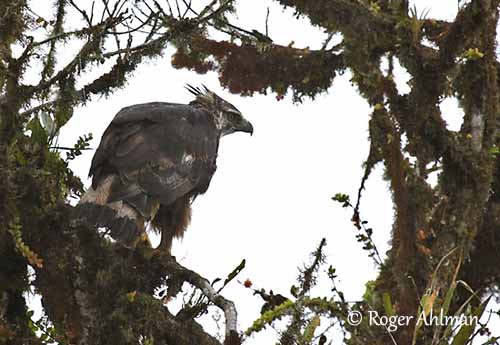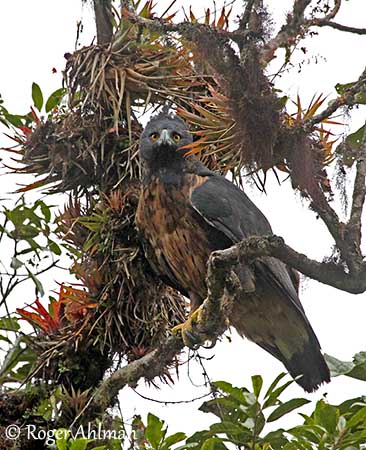
Fr: Aigle d’Isidore
Ang: Black-and-chestnut Eagle
All: Isidoradler
Esp: Águila Poma, Águila Crestada, Águila de Copete,
Ita: Spizaeto nero e castano
Nd: Andeskuifarend
Sd: Isidors örn
Photographer:
Roger Ahlman
Pbase Galleries Peru and Ecuador
Text by Nicole Bouglouan
Sources:
HANDBOOK OF THE BIRDS OF THE WORLD Vol 2 by Josep del Hoyo-Andrew Elliot-Jordi Sargatal - Lynx Edicions - ISBN: 8487334156
A GUIDE TO THE BIRDS OF COLOMBIA by Steven L. Hilty and William L. Brown - Princeton University Press – ISBN 069108372X
L’ENCYCLOPEDIE MONDIALE DES OISEAUX - Dr Christopher M. Perrins - BORDAS - ISBN: 2040185607
BirdLife International (BirdLife International)
Neotropical Birds – Cornell Lab of Ornithology
Global Raptor Information Network - Working to Conserve Birds of Prey in nature
Wikipedia, the free encyclopaedia
Black-and-chestnut Eagle
Spizaetus isidori
Accipitriformes Order – Accipitridae Family
INTRODUCTION:
The Black-and-chestnut Eagle is a stocky and powerful raptor. Formerly placed in the monotypic genus Oroaetus, it is now included in the New World Spizaetus group.
This fairly large south-American eagle is known to prey on medium-sized arboreal mammals and birds as large as guans (Cracidae). It occurs in humid montane forests at high elevation, but the species is usually local and rare.
DESCRIPTION OF THE BIRD:
Biometrics:
Length: 64-74 cm
Wingspan: 144-166 cm
The adult has black head, crest, neck and upperparts. The tail is mostly greyish with broad, black subterminal band.
The underparts are chestnut with black streaks, and the thighs are black, whereas the feathered tarsi are chestnut. On the underwing, the primaries are whitish with black tips, and the secondaries and underwing-coverts are chestnut.
Head and neck are black. The black crest is often held elevated in flight, and lowered in stressful situations.
The bill is blackish-brown with yellowish cere. The eyes are yellow-orange. The feet are yellow with strong, black talons.
Both sexes are similar, but the female is larger, and she has longer tail.

The immature is brownish above, whereas head, neck and underparts are white. The tail shows two blackish bands above the broader subterminal band. The crest is tipped black.
The young birds become progressively darker over four years.
The subadult is dark but blotchy and mottled.
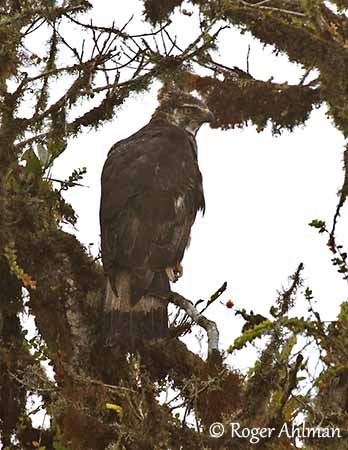
RANGE:
The Black-and-chestnut Eagle is found along the coastal regions of NW Venezuela and NE Colombia, also on the subtropical slopes of the Andes through Ecuador, Peru, Bolivia and NW Argentina. It can be seen from sea-level up to 3500 metres, but the species is usually found between 1500 and 2800 metres of elevation.
HABITAT:
The Black-and-chestnut Eagle is usually found in dense, undisturbed wet cloud forest on slopes, both at middle and high elevations.
CALLS AND SONGS: SOUNDS BY XENO-CANTO
The Black-and-chestnut Eagle is rather quiet and silent outside the breeding season. However, near the nest, the adults give loud “pe-e-e-eo”, and high-pitched “chee-chee-chee” in alarm.
The most common call is a series of monotonous whistles “keeeuw… keeeuw…”. The fledglings give series of yelping whistles “yeeew yeeew yeeew”.
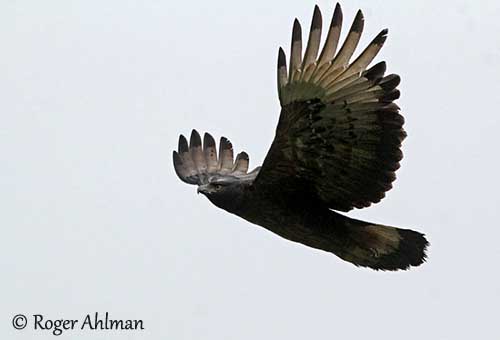
BEHAVIOUR IN THE WILD:
The Black-and-chestnut Eagle feeds on medium-sized arboreal mammals and birds. Mammal preys include squirrels (mainly used for feeding the chicks), monkeys (Lagothrix), sloths, tree porcupines and coatis. Bird preys are mainly guans (Cracidae) whereas immature eagles often take domestic chickens.
This raptor hunts by soaring around tree tops. It is rarely seen perched, and usually swoops down onto the prey and through the tree branches. It often has much abraded tail feathers due to its hunting behaviour.
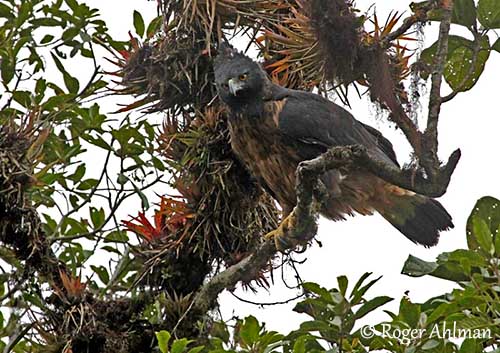
In the same way, the Black-and-chestnut Eagle collects green branches for the nest, by diving from the air and snatching a branch while passing.
There is no information about the courtship displays, but usually, the eagles of genus Spizaetus perform aerial displays. Both mates soar above the territory while calling, or perform an undulating flight display.
The Black-and-chestnut Eagle is probably sedentary.
It soars regularly over the forest and appears powerful while flying.
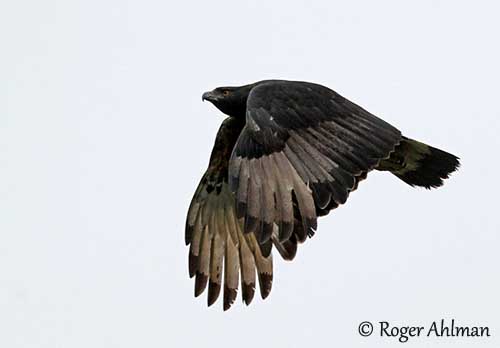
REPRODUCTION OF THIS SPECIES:
The breeding season starts in February/March with the nest building, but it may vary according to the range such as in Bolivia where this period occurs a bit later.
The Black-and-chestnut Eagle builds a large stick nest of up to two metres wide and one metre deep. This huge structure is placed in high location in an emergent tree or in tree on side of ravine. It brings green vegetation to the nest from time to time. The nest can be up to 20 metres or more above the ground.
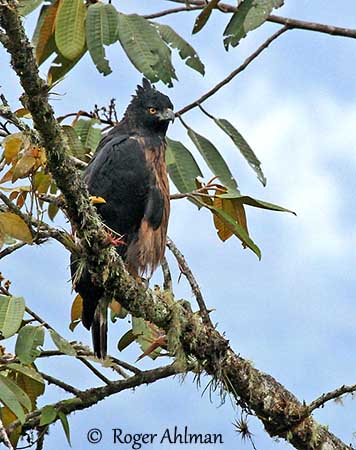
The female lays a single white egg with dark brown spots. The length of the incubation is unknown, but usually lasts between 40 and 48 days in the genus Spizaetus. The young fledges 110-130 days after hatching.
The male feeds the female during the incubation and provides food for the chick, usually squirrels.
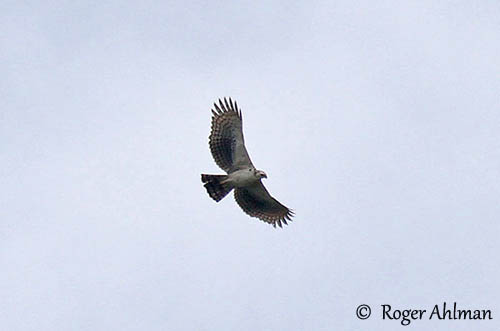
PROTECTION / THREATS / STATUS:
The Black-and-chestnut Eagle has small population placed in the band 250/999 mature individuals. Based on each subpopulation, the global population is estimated at 370/1500 individuals.
This species is threatened by habitat loss due to destruction of primary forest-habitat. Some birds can be seen in partially logged tracts, probably displaced from their usual habitat.
In addition, this species is persecuted and killed in Colombia, due to more frequent contact with humans and livestock, after loss of forest-habitat.
The Black-and-chestnut Eagle is currently classified as Endangered.
